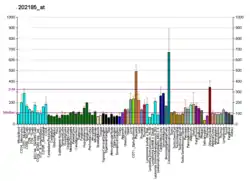PLOD3
Procollagen-lysine,2-oxoglutarate 5-dioxygenase 3 is an enzyme that in humans is encoded by the PLOD3 gene.[5][6][7]
The protein encoded by this gene is a membrane-bound homodimeric enzyme that is localized to the cisternae of the rough endoplasmic reticulum. The enzyme (cofactors iron and ascorbate) catalyzes the hydroxylation of lysyl residues in collagen-like peptides. The resultant hydroxylysyl groups are attachment sites for carbohydrates in collagen and thus are critical for the stability of intermolecular crosslinks. Some patients with Ehlers-Danlos syndrome type VIB have deficiencies in lysyl hydroxylase activity.[7]
References
- GRCh38: Ensembl release 89: ENSG00000106397 - Ensembl, May 2017
- GRCm38: Ensembl release 89: ENSMUSG00000004846 - Ensembl, May 2017
- "Human PubMed Reference:". National Center for Biotechnology Information, U.S. National Library of Medicine.
- "Mouse PubMed Reference:". National Center for Biotechnology Information, U.S. National Library of Medicine.
- Passoja K, Rautavuoma K, Ala-Kokko L, Kosonen T, Kivirikko KI (Sep 1998). "Cloning and characterization of a third human lysyl hydroxylase isoform". Proc Natl Acad Sci U S A. 95 (18): 10482–10486. doi:10.1073/pnas.95.18.10482. PMC 27920. PMID 9724729.
- Valtavaara M, Szpirer C, Szpirer J, Myllyla R (Jun 1998). "Primary structure, tissue distribution, and chromosomal localization of a novel isoform of lysyl hydroxylase (lysyl hydroxylase 3)". J Biol Chem. 273 (21): 12881–12886. doi:10.1074/jbc.273.21.12881. PMID 9582318.
- "Entrez Gene: PLOD3 procollagen-lysine, 2-oxoglutarate 5-dioxygenase 3".
Further reading
- Salo AM, Wang C, Sipilä L, et al. (2006). "Lysyl hydroxylase 3 (LH3) modifies proteins in the extracellular space, a novel mechanism for matrix remodeling". J. Cell. Physiol. 207 (3): 644–653. doi:10.1002/jcp.20596. PMID 16447251. S2CID 19594208.
- Otsuki T, Ota T, Nishikawa T, et al. (2007). "Signal sequence and keyword trap in silico for selection of full-length human cDNAs encoding secretion or membrane proteins from oligo-capped cDNA libraries". DNA Res. 12 (2): 117–126. doi:10.1093/dnares/12.2.117. PMID 16303743.
- Rual JF, Venkatesan K, Hao T, et al. (2005). "Towards a proteome-scale map of the human protein-protein interaction network". Nature. 437 (7062): 1173–1178. doi:10.1038/nature04209. PMID 16189514. S2CID 4427026.
- Gerhard DS, Wagner L, Feingold EA, et al. (2004). "The status, quality, and expansion of the NIH full-length cDNA project: the Mammalian Gene Collection (MGC)". Genome Res. 14 (10B): 2121–2127. doi:10.1101/gr.2596504. PMC 528928. PMID 15489334.
- Hillier LW, Fulton RS, Fulton LA, et al. (2003). "The DNA sequence of human chromosome 7". Nature. 424 (6945): 157–164. doi:10.1038/nature01782. PMID 12853948.
- Strausberg RL, Feingold EA, Grouse LH, et al. (2003). "Generation and initial analysis of more than 15,000 full-length human and mouse cDNA sequences". Proc. Natl. Acad. Sci. U.S.A. 99 (26): 16899–16903. doi:10.1073/pnas.242603899. PMC 139241. PMID 12477932.
- Wang C, Luosujärvi H, Heikkinen J, et al. (2003). "The third activity for lysyl hydroxylase 3: galactosylation of hydroxylysyl residues in collagens in vitro". Matrix Biol. 21 (7): 559–566. doi:10.1016/S0945-053X(02)00071-9. PMID 12475640.
- Rautavuoma K, Takaluoma K, Passoja K, et al. (2002). "Characterization of three fragments that constitute the monomers of the human lysyl hydroxylase isoenzymes 1–3. The 30-kDa N-terminal fragment is not required for lysyl hydroxylase activity". J. Biol. Chem. 277 (25): 23084–23091. doi:10.1074/jbc.M112077200. PMID 11956192.
- Ruotsalainen H, Vanhatupa S, Tampio M, et al. (2001). "Complete genomic structure of mouse lysyl hydroxylase 2 and lysyl hydroxylase 3/collagen glucosyltransferase". Matrix Biol. 20 (2): 137–146. doi:10.1016/S0945-053X(01)00130-5. PMID 11334715.
- Heikkinen J, Risteli M, Wang C, et al. (2000). "Lysyl hydroxylase 3 is a multifunctional protein possessing collagen glucosyltransferase activity". J. Biol. Chem. 275 (46): 36158–36163. doi:10.1074/jbc.M006203200. PMID 10934207.
- Rautavuoma K, Passoja K, Helaakoski T, Kivirikko KI (2000). "Complete exon-intron organization of the gene for human lysyl hydroxylase 3 (LH3)". Matrix Biol. 19 (1): 73–79. doi:10.1016/S0945-053X(99)00058-X. PMID 10686427.
This article is issued from Wikipedia. The text is licensed under Creative Commons - Attribution - Sharealike. Additional terms may apply for the media files.





